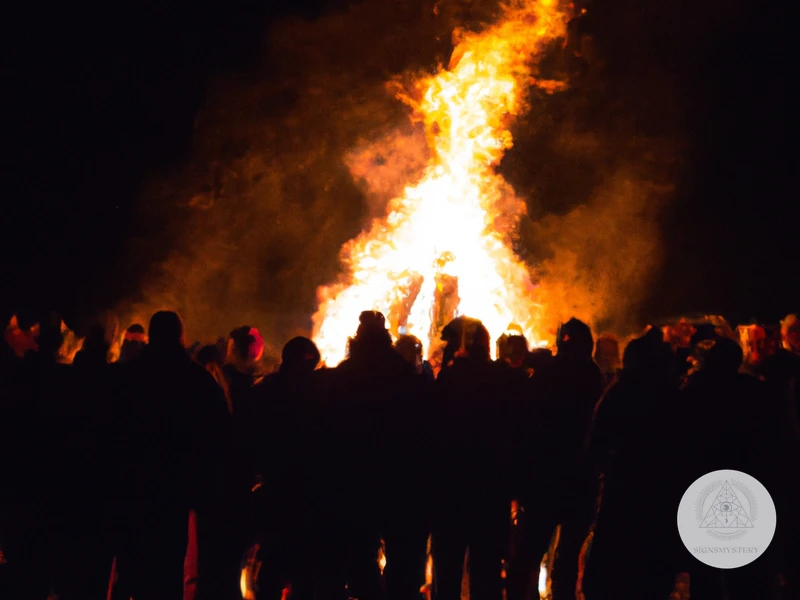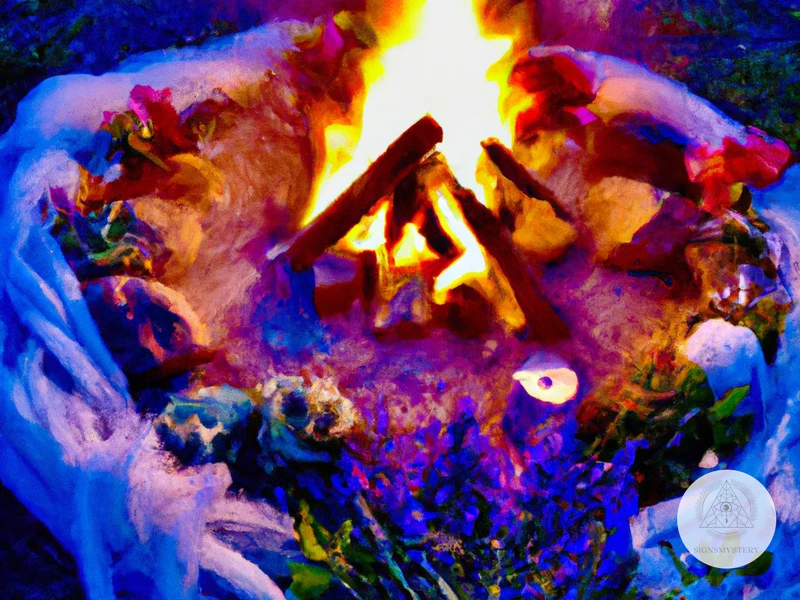Shamanism is an ancient practice that involves the connection and communication between humans and the spirit world. It is a way of life that seeks to restore balance and harmony within the self, the community, and nature. One of the most important aspects of shamanism is the use of ceremonies to facilitate healing and transformation. Fire ceremonies have been a significant part of shamanic traditions for thousands of years, and their purpose goes beyond just keeping warm or cooking food. The flames represent the powerful energy of transformation, purification, and illumination. In this article, we will explore the purpose of fire ceremonies in shamanism, and how they can ignite the soul’s fire.
What is Shamanism?
Shamanism is a spiritual practice that focuses on connecting with nature, ancestors, and spirits for healing and guidance. It is a way to access the unseen realms and gain wisdom from the spiritual world. Shamanism is a practice that has been around for centuries and is still prevalent in many cultures today. Shamans use various tools, such as drums, rattles and sacred plants, to help them enter a trance-like state to connect with spirit guides and ancestors. The practice of shamanism involves cleansing rituals, shamanic dancing, and shamanic ceremonies to help individuals connect with their inner selves and the spiritual realm. Shamanism is a powerful practice that can help individuals gain a deeper understanding of themselves and the world around them.
What are Fire Ceremonies?
Fire ceremonies are an ancient shamanic practice that involves the use of fire as a powerful tool for healing, transformation, and spiritual growth. In a fire ceremony, participants gather together around a sacred fire and engage in a series of rituals, which may include singing, dancing, prayer, and meditation. Fire ceremonies are performed by shamans and spiritual leaders in many different cultures around the world, from Native American tribes to the ancient cultures of India and Tibet.
During the fire ceremony, the fire is regarded as a living entity, with its own spirit and energy. The ceremony serves to connect participants with the power of the fire and its transformative qualities. The fire is viewed as a potent symbol of purification, illumination, and renewal, and is said to have the ability to burn away negative energies and old patterns of behavior, paving the way for new growth and positive change.
Fire ceremonies can take many forms, depending on the culture and the intention of the ceremony. In some traditions, the fire may be used for physical healing, with participants offering prayers and offerings to the fire to invoke its healing power. In other traditions, the ceremony may be focused on emotional or spiritual healing, with participants using the fire as a tool for inner reflection and self-discovery.
Fire ceremonies are a powerful way to connect with the sacred elements of nature and harness their energy for personal transformation and growth. Whether you are seeking healing, guidance, or simply a deeper connection to your spiritual path, participating in a fire ceremony can be a profound and transformative experience.
Links that may help you to get more information:
- Shaman Cleansing Rituals
- Shamanic Drumming Healing
- Music in Shamanic Ceremonies
- Ancestral Spirit Rituals
- Shamanic Dance Significance
- Power of Intention in Shamanic Ceremonies
- Shamanic Tools in Rituals and Ceremonies
- Personalized Ritual Practice in Shamanism
- Sacred Plants in Shamanic Ceremonies
The Importance of Fire in Shamanic Traditions
In shamanic traditions, fire is an essential element that represents transformation, purification, and new beginnings. Fire is believed to have profound power that can cleanse and purify the energy of the individual and the environment. In shamanic cultures, fire is often used as a medium for connecting with the spiritual realm and for receiving guidance and wisdom from the ancestors and spirit guides.
Shamans use fire as a source of power to channel their inner strength and spiritual energy. Fire is seen as an embodiment of the divine spirit that can help the shaman enter altered states of consciousness and access the hidden realms of the spiritual world. The sound and the warm glow of the fire can facilitate the shaman’s journey and provide a sense of security and protection.
Fire is also a symbol of the life force energy that flows through all living beings. The fire’s flames represent the upward energy that rises from the earth, connecting us to the heavens and the cosmic forces. The heat of the fire represents the transformative power of the life force energy that can blaze through the individual’s soul and ignite their passion and purpose.
In shamanic traditions, fire is often used to purify and release negative energies and emotions. The flames burn away the old, stagnant energy, and make space for new growth and transformation. The ashes and embers of the fire are believed to hold the energy of the ceremony that can be offered to the earth, thus completing the cycle of transformation and renewal.
Fire is crucial in shamanic traditions as it represents the transformative power of the life force energy and provides the shaman with a source of strength and guidance. The fire is seen as a living entity that can facilitate the connection between the individual and the spiritual realm, as well as aid in purification and release of negative energies.
The Healing Power of Fire Ceremonies

Fire ceremonies have been used in shamanic traditions for centuries as a way of connecting with the spiritual world. These ceremonies are believed to have tremendous healing power that can help individuals overcome physical, emotional, and spiritual challenges in their lives.
Physical Healing
Fire is considered a symbol of transformation and purification in many shamanic cultures. The heat and light created by fire are believed to have powerful healing properties that can help to restore balance and harmony in the body. During a fire ceremony, participants often focus on specific areas of the body that are in need of healing and offer prayers and offerings to the spirits for assistance. This can help to promote healing on both a physical and energetic level.
Emotional and Spiritual Healing
Fire ceremonies are known for their ability to bring about emotional and spiritual healing as well. By participating in a fire ceremony, individuals can release negative emotions and energies that are holding them back and gain a deeper understanding of themselves and their place in the world. Fire ceremonies can also help to strengthen one’s connection to spirit guides, ancestors, and the natural world, providing a sense of inner peace and clarity.
Connecting with Ancestors and Spirit Guides
In shamanic traditions, fire is often considered a doorway to the spiritual world. By kindling a sacred fire and offering prayers and gifts, individuals can invite their ancestors and spirit guides to take part in the ceremony and offer guidance and support. This can be a powerful way to connect with one’s ancestors and lineage and to gain a deeper understanding of one’s personal history and spiritual path.
Fire ceremonies have tremendous healing power that can help individuals overcome physical, emotional, and spiritual challenges in their lives. Whether used for individual healing or as part of a community ceremony, the transformative power of fire can provide a profound sense of connection, transformation, and renewal.
Physical Healing
Physical healing is just one aspect of the transformative power of fire ceremonies in shamanism. Fire has long been recognized for its regenerative properties, and ancient healers would use flames to cauterize wounds and injuries. Today, fire ceremonies can still be used for physical healing, whether the goal is to recover from an acute injury or to manage chronic pain. By exposing oneself to the heat of the flames and focusing intention on the body’s healing, individuals can activate their own inherent healing mechanisms. Certain herbs and other materials can be added to the fire to create smoke that has medicinal properties. For example, burning sage or palo santo has been shown to release molecules that have antimicrobial properties, and inhaling the smoke can clear the respiratory system. Fire ceremonies can also provide a space for profound relaxation, which can positively impact the body’s ability to heal. The power of fire for physical healing is real, and many have found relief and recovery from chronic pain and other ailments through the transformative practice of fire ceremonies.
Emotional and Spiritual Healing
Emotional and spiritual healing is one of the main benefits of fire ceremonies in Shamanism. Through the powerful energy of fire, individuals can release negative emotions, trauma, and blockages that are holding them back. The warmth and light of the flames create a safe and sacred space for individuals to connect with their inner selves, allowing them to find deep healing, clarity, and inner peace.
Some of the emotional and spiritual healing benefits of fire ceremonies in Shamanism include:
| Healing Benefit | Description |
|---|---|
| Releasing Negative Emotions | Fire ceremonies allow individuals to release negative emotions such as anger, fear, and sadness. By acknowledging and surrendering these emotions to the fire, individuals can let go of the burden and feel lighter and more at peace. |
| Healing Trauma | Fire ceremonies can help individuals to heal from past trauma. By calling upon the power of the fire, individuals can transform their trauma into strength and courage, and release painful memories that are holding them back. |
| Connecting with Spirit Guides | The intense energy of the fire can open up channels of communication with spirit guides, ancestors, and higher selves. Through fire ceremonies, individuals can receive messages, guidance, and support from their spiritual helpers, leading to a deeper sense of understanding and purpose. |
| Inviting Positive Energy | Fire ceremonies can help to invite positive energy and blessings into one’s life. By setting intentions and offering prayers and gifts to the fire, individuals can create a powerful intention that attracts positive energy and good fortune. |
| Empowering the Self | The process of surrendering to the fire and letting go of negative emotions and limiting beliefs can lead to a greater sense of personal power and self-love. Fire ceremonies can help individuals to connect with their true selves, find their inner strength, and step into their full potential. |
Fire ceremonies in Shamanism offer a unique and transformative opportunity for emotional and spiritual healing. Through the power of the fire, individuals can release negative emotions, heal trauma, connect with higher beings, and empower themselves to live a more fulfilling and purposeful life.
Connecting with Ancestors and Spirit Guides
Connecting with Ancestors and Spirit Guides during a fire ceremony is an important aspect of Shamanism. Shamans believe that these spiritual entities can provide guidance and wisdom to individuals during their journey towards physical and emotional healing and self-discovery.
To connect with Ancestors and Spirit Guides during a fire ceremony, one must first set the intention for this purpose. It is important to be respectful and humble towards these entities, acknowledging their existence and their importance in the spiritual realm.
During the ceremony, Shamans may use items such as feathers, stones, or crystals to act as a channel between themselves and the spirits they wish to connect with. These items are believed to hold a spiritual energy that allows the Shaman to tap into the realm of spirits and ancestors.
Another way to connect with Ancestors and Spirit Guides during a fire ceremony is through drumming and chanting. This is a way to create a trance-like state that allows the Shaman to enter into a deeper level of consciousness and access the spiritual realm more easily.
It is important to note that the experience of connecting with Ancestors and Spirit Guides may vary from person to person, and may not always be a visual or auditory experience. It may manifest as a feeling or a sense of knowing or understanding.
Connecting with Ancestors and Spirit Guides during a fire ceremony is a sacred and powerful experience that can provide individuals with guidance, clarity, and a deeper sense of connection with the spiritual realm. It is a reminder of the interconnectedness of all things, and the importance of respecting and honoring the wisdom and guidance of those who came before us.
Preparing for a Fire Ceremony
When preparing for a fire ceremony, there are several important factors to consider to ensure that the ceremony is conducted in a safe and sacred manner. Here are some important steps to follow:
Choose a location that feels safe and sacred to you. This could be in your backyard, in the woods, or on a beach. Make sure that fires are allowed in the area and that you have permission to light one.
You will need to gather materials to build the fire. These include logs, kindling, and matches or a lighter. Additionally, consider bringing offerings such as herbs, flowers, or crystals to place on the altar or offer to the fire.
Before the ceremony, it is important to cleanse and purify the space and yourself. This can be done through smudging with sage, palo santo, or other sacred herbs. You can also take a ritual bath or shower to cleanse yourself. Set your intention for the ceremony and connect with your inner self.
Here is a checklist of things to consider when preparing for your fire ceremony:
| Step | Action |
|---|---|
| 1 | Select location |
| 2 | Gather fire materials: logs, kindling, matches, or lighter |
| 3 | Consider offerings: herbs, flowers, crystals |
| 4 | Cleanse and purify space and self through smudging, ritual bath or shower |
| 5 | Set intention for the ceremony |
By taking the time to prepare and create a sacred space for the fire ceremony, you are opening yourself up to a transformative experience. Remember to approach the ceremony with respect and mindfulness, and trust that the power of the fire will guide and heal you.
Selecting the Right Location
The location of a fire ceremony is crucial in Shamanism as it sets the stage for the ritual. When selecting the right location, it is important to consider the natural elements, such as earth, water, air, and fire. Each element can contribute to the energy and atmosphere of the ceremony. Additionally, the location should have special significance for the participants, such as a place with spiritual connections or meaningful memories. It is also important to choose a quiet and secluded area where participants can feel comfortable and undisturbed. Finally, safety should always be a top priority when selecting a location, with a flat area clear of any flammable objects and access to a water source in case of emergencies. By selecting the right location, participants can create a sacred space where they can connect with the spirit world and ignite the fire of their soul.
Gathering Materials and Offerings
When preparing for a fire ceremony, it’s crucial to gather the right materials and offerings. Here are some essential items to include:
| Firewood: | Choose dry, seasoned wood to ensure an easy and consistent burn. Traditionally, specific types of wood are preferred depending on the purpose of the ceremony. For example, cedar is often used for cleansing and purification while oak is associated with strength and power. |
| Herbs: | Select herbs that align with the intention of the ceremony. Sage, sweetgrass, and tobacco are commonly used for cleansing and purifying the space, while lavender, rose petals, and chamomile are used to promote relaxation and healing. |
| Offerings: | Offerings can range from food and drink to other symbolic items. In shamanic traditions, it’s believed that these offerings provide a physical representation of gratitude and reverence for the spirits and ancestors. Consider including items like fruit, chocolate, flowers, or crystals. |
| Drums and other musical instruments: | Music and rhythm play an integral role in fire ceremonies. Drums, rattles, flutes, and singing bowls can help set the tone and energy of the ceremony. |
| Clothing: | Choose clothing that is comfortable and allows for freedom of movement. It’s also essential to consider the weather and dress appropriately for the location and time of day. |
It’s important to remember that the items chosen for the ceremony should be chosen with intention and reverence. Take the time to connect with each item, and infuse them with your energy and intention for the ceremony. In doing so, you’ll create a powerful and meaningful experience for yourself and the other participants.
Cleansing and Purification
Cleansing and purification are an essential part of the preparation for a fire ceremony in shamanism. The act of purifying oneself allows for a deeper connection to be made with the sacred fire and with one’s spirit helpers. It is believed that the fire has the power to burn away negative energy and purify the soul.
There are various methods of cleansing and purification used in shamanism, some of which involve the use of sage, sweetgrass, tobacco, or other herbs. These can be burned and the smoke is used to cleanse and purify the surroundings and the participants.
Another way to cleanse and purify is through the use of sound. This can be achieved through the use of drums, rattles, or chanting. The vibrations produced by these sounds create a powerful cleansing effect that can be felt both physically and spiritually.
A ritual bath or shower can also be used for cleansing and purification. This involves the use of water, which is a powerful symbol of purification in many spiritual and religious traditions. Participants may be instructed to visualize the water washing away negative energy and leaving them feeling refreshed and renewed.
Whatever method is used, the intention behind the cleansing and purification is to release any negative energy, thoughts, or emotions that may be blocking the participant from fully connecting with the sacred fire. This process serves as a way to cleanse the body, mind, and spirit, and to prepare them for the transformative experience of the fire ceremony.
The Elements of a Fire Ceremony

Setting Intentions
Before beginning the fire ceremony, it’s important to set clear intentions. This could be something as simple as a prayer or a mantra, or it could involve a more elaborate visualization or meditation. The key is to focus on what you hope to achieve through the ceremony, and to visualize your goals as clearly as possible.
Kindling the Sacred Fire
Once you’ve set your intentions, it’s time to kindle the sacred fire. This can be done using traditional materials such as dry wood, sage, or palo santo. As you do so, take a moment to offer your gratitude to the fire and to ask for its assistance in your healing journey.
Offering Prayers and Gifts
As the fire begins to take hold, it’s common to offer prayers and gifts to the spirits or ancestors that you hope to connect with. This could involve placing offerings of food, herbs, or other materials into the fire, or simply reciting prayers or mantras to invite their presence.
Engaging in Ritual Dance and Song
Once the fire has been lit, it’s common to engage in ritual dance and song as a way of expressing your gratitude and honoring the spirits. This could involve traditional shamanic drumming, singing, or other forms of musical expression. The goal is to enter into a meditative state where you can connect with the spirits and allow the energy of the fire to guide you.
The elements of a fire ceremony are designed to help you connect with your inner self, unlock deep spiritual insights, and heal
Subscribe to Our Newsletter
Sign up to receive the latest news and updates.
Setting Intentions
Setting intentions is a crucial step in any fire ceremony as it helps the participant align their thoughts and energies towards a specific goal or purpose. The first step in setting intentions is identifying what you want to accomplish or manifest in your life. This could be anything from physical health, emotional well-being, financial stability, or spiritual growth. Once you have identified your intention, write it down on a piece of paper or a small rock, and place it on the altar or in the fire. This act of physical manifestation reinforces your intention, and sending it off into the fire ignites the necessary energies to bring your intention into reality. It is important to remember that intentions should always be positive and aligned with your higher self. Setting multiple intentions is also acceptable, but it’s important to prioritize and focus on the one that resonates with you the strongest.
Kindling the Sacred Fire
One of the key elements of a fire ceremony in shamanism is the kindling of the sacred fire. This is the moment when the shamans or participants prepare to ignite the fire that will serve as a focal point for the ceremony. The fire is seen as a symbol of transformation, purification, and renewal. It represents the light of life and the energy that sustains the universe. The act of kindling the fire is therefore a sacred ritual that requires intention, focus, and reverence.
Before the ceremony, participants will gather wood and other materials for the fire. They may select certain types of wood or herbs that have symbolic meanings in shamanism. For example, cedar is often used to purify the space and promote healing, while tobacco is seen as a means of communicating with the spirit world. The wood and materials are arranged in a specific way, often in the form of a teepee or circle, and then set ablaze using a variety of traditional methods.
The ceremony itself may involve chanting, drumming or other forms of music, as well as dancing or other physical movements. The fire acts as a focal point for these activities, serving as a conduit for the energy of the ceremony. Participants may offer prayers or vows to the fire, asking for healing, guidance, or other blessings.
As the fire burns, it is believed to be cleansing and purifying both the physical space and the spiritual energy of the participants. The heat and light of the fire are seen as a transformative force, melting away negative energy and promoting positive change. It is common for participants to meditate or reflect on their intentions while gazing into the flames.
At the end of the ceremony, the fire may be extinguished in a specific way, often with water or a chosen herb. The ashes and remaining materials are typically disposed of in a reverent manner.
The act of kindling the sacred fire represents the beginning of the shamanic journey. It is a powerful moment that sets the stage for the transformative process that follows. By focusing their intention and energy on the fire, participants are able to tap into the power of the universe and connect with their own spiritual essence.
Offering Prayers and Gifts
Offering prayers and gifts is a significant component of a fire ceremony, as it creates a sense of gratitude and humbleness towards the divine spirits and our ancestors.
When we offer prayers, it is essential to speak from the heart and express our deepest desires and intentions with conviction. This is not a time for superficial requests. Instead, it is an opportunity to connect authentically with the divine and ask for guidance in our journey towards self-discovery and spiritual growth.
As for gifts, they are commonly used to represent our gratitude towards the spirits. As we give these gifts, we acknowledge the abundance of blessings in our lives and the support we receive from the spiritual realm. It’s also a beautiful way to show our appreciation for the use of the natural materials we gathered.
The following are some of the traditional gifts people offer during fire ceremonies:
| Gift | Symbolism |
|---|---|
| Tobacco | Represents the breath of the divine. Offering tobacco is a gesture of asking for wisdom and guidance from the spirits. |
| Sage, Cedar, or Sweetgrass | Represents the cleansing and purifying of the ceremony. |
| Feathers | Represents the connection to the spirit world as birds are regarded as messengers in many indigenous cultures. |
| Seashells or Stones | Represents the elements of the earth and our interconnectedness with nature. |
It’s important to note that the gifts don’t have to be physical objects. Giving thanks and expressing genuine gratitude can also be considered as gifts to the spirits.
Offering prayers and gifts during a fire ceremony is a profound way to connect with the spiritual realm, express gratitude, and ask for guidance. It’s an opportunity to be humbled, centered, and renewed.
Engaging in Ritual Dance and Song
Engaging in ritual dance and song is an essential part of fire ceremonies in shamanism. Ritual dance and song have been used by shamanic practitioners for centuries to connect with the spirit world, gain wisdom, and heal the body and mind. Dancing and chanting create a heightened state of consciousness, where one can reach an altered state of perception and connect with the energies and entities of the spirit realm.
Ritual Dance: During a fire ceremony, ritual dance is performed to honor the spirits, ancestors, and deities. The dance can be performed individually or in a group and involves various movements of the body. These movements are intended to stimulate the flow of energy within the body, creating a connection with the spiritual world. The dance can be slow and meditative or fast and energetic, depending on the intention and mood of the ceremony.
Ritual Song: Ritual song is another integral part of fire ceremonies in shamanism. These songs are sung to evoke specific spirits or deities, to express gratitude, or to ask for healing or guidance. The songs are often repetitive and simple, allowing the shaman and participants to enter a trance-like state. The words and melody of the song can be improvised or passed down through generations.
The Benefits: Engaging in ritual dance and song during a fire ceremony can have numerous benefits. It can help release pent-up emotions, promote relaxation, reduce stress, and improve overall well-being. Additionally, these practices help to foster a sense of community and spiritual connection among the participants.
Engaging in ritual dance and song during fire ceremonies is an essential aspect of shamanic practice. It assists practitioners in connecting with the spiritual realm, gaining insights, and promoting whole-body healing. It is a powerful form of expression that transcends language and cultural barriers and brings individuals together in a meaningful way.
The Aftermath of a Fire Ceremony
Integration: After a fire ceremony, it’s common to feel a sense of transformation and renewal. It’s essential to give yourself time to integrate these changes into your daily life. You may find it helpful to reflect on the experience and write down any insights that come to mind. Look for ways to incorporate these lessons into your daily routine, like practicing gratitude or setting intentions for the day. Remember that integration is a gradual process, and being patient with yourself is essential.
Spiritual Growth and Self-Discovery: Fire ceremonies can facilitate spiritual growth and self-discovery. The intense energy of the fire can help release emotional blockages and connect you to your inner wisdom. It can spark creative ideas and inspire you to live your life more authentically. You may find that you have a renewed sense of purpose or clarity about your life path. Remember to stay open to the possibilities and allow the experience to guide you on your journey.
Fire ceremonies are powerful tools for healing, transformation, and spiritual growth. By setting intentions, kindling the sacred fire, offering prayers, and engaging in ritual dance and song, we can ignite the soul’s fire and connect to our inner wisdom. After the ceremony, taking time to integrate the experience and reflect on any insights can help us live more authentically and align with our life path.
Integration
Integration is a crucial part of any healing process, including a fire ceremony. After the intensity of the ceremony, it’s important to take time to process and integrate the experience into daily life. One way to do this is to spend some quiet time alone, journaling or meditating on the insights gained during the ceremony. It’s also helpful to discuss the experience with a trusted friend or shamanic practitioner to further explore its meaning. Additionally, incorporating new practices or habits into daily life that align with the intentions set during the ceremony can help solidify the lasting effects of the experience. Taking intentional steps towards integration can enhance the benefits of a fire ceremony and facilitate lasting transformation.
Spiritual Growth and Self-Discovery
Spiritual growth and self-discovery are key elements of fire ceremonies in shamanism. By participating in a fire ceremony, individuals have the opportunity to connect with their inner selves and align their energies with their deepest desires and intentions.
During a fire ceremony, participants are encouraged to release any negative emotions or energies that may be holding them back. This process of release allows individuals to let go of any limiting beliefs or patterns that are preventing them from experiencing spiritual growth and self-discovery.
The sacred fire is believed to hold transformative powers that can facilitate this process of release and transformation. By connecting with the energy of the fire and offering sincere intentions, participants can tap into their own inner power and align their energies with their highest selves.
As a result of participating in fire ceremonies, individuals may experience a greater sense of clarity, purpose, and direction in their lives. They may also feel a deeper connection to their spiritual path and a stronger sense of connection to the divine.
To maximize the spiritual growth and self-discovery potential of a fire ceremony, it is important to approach the experience with an open mind and heart. Participants should be willing to let go of any preconceived notions or expectations and allow themselves to be fully present in the moment.
In addition to participating in fire ceremonies, individuals can also enhance their spiritual growth and self-discovery through other practices such as meditation, journaling, and spending time in nature. By cultivating a daily spiritual practice, individuals can continue to deepen their connection to their inner selves and experience greater levels of spiritual growth and self-discovery.
Fire ceremonies offer a powerful opportunity for spiritual growth and self-discovery. Through connecting with the transformative power of the sacred fire, individuals can release limiting patterns, align with their highest selves, and tap into their own inner power and wisdom.
Conclusion
Conclusion: Fire ceremonies have been a part of shamanic traditions for centuries, serving as a powerful tool for healing, connecting with the spiritual realm, and igniting the soul’s fire. These ceremonies can offer physical, emotional, and spiritual healing, as well as provide a space for introspection and personal growth.
In this article, we have explored the origins of shamanism and fire ceremonies, discussed the importance of fire in shamanic traditions, and delved into the different elements of a fire ceremony. We have also explored how to prepare for a fire ceremony, including selecting the right location, gathering materials and offerings, and performing cleansing and purification rituals.
During a fire ceremony, the setting of intentions, kindling of the sacred fire, offering of prayers and gifts, and engaging in ritual dance and song all play integral roles. And after the ceremony, the integration of the experience and the pursuit of spiritual growth and self-discovery can continue.
Overall, fire ceremonies offer an opportunity to connect with our ancestral roots, our innate spiritual selves, and the larger universe. In the words of the great shaman Don Jose Ruiz, “Fire ceremonies remind us that we are all connected. We are all together. We must work together, love together, and grow together.”
Frequently Asked Questions
What is the origin of shamanism?
Shamanism has roots in indigenous cultures around the world, with some of the earliest evidence dating back to Paleolithic times.
Do you need to be a shaman to participate in a fire ceremony?
No, anyone can participate in a fire ceremony and benefit from its healing and transformative effects.
How long does a typical fire ceremony last?
This can vary depending on the specific traditions and intentions of the ceremony, but they are often around 2-4 hours in length.
What materials are needed for a fire ceremony?
The materials needed can include firewood, matches or a lighter, offerings such as herbs or flowers, and a container for collecting ashes after the fire has burned out.
What health benefits can be gained from a fire ceremony?
A fire ceremony can help to release physical tension and stress, lower blood pressure, and boost the immune system.
Is it necessary to have experience in shamanism before attending a fire ceremony?
No, experience in shamanism is not required. However, it may be helpful to research and understand the basic principles of shamanic practices beforehand.
What is the purpose of setting intentions before a fire ceremony?
Setting intentions helps to focus the mind and direct the energy of the ceremony towards specific goals, whether they be personal healing, spiritual growth, or connection with one’s ancestors.
Can fire ceremonies be done alone or is a group required?
Fire ceremonies can be done alone, but they are often more powerful in a group setting, as the collective energy and intention can amplify the effects of the ceremony.
What is the role of dance and song in fire ceremonies?
Dance and song help to activate the energy of the ceremony and create a sacred space where participants can connect with the spiritual realm.
How often should fire ceremonies be conducted?
This is up to personal discretion and the specific needs of the individual or group. Some may benefit from conducting fire ceremonies regularly, such as once a month, while others may find that less frequent ceremonies are more effective.










